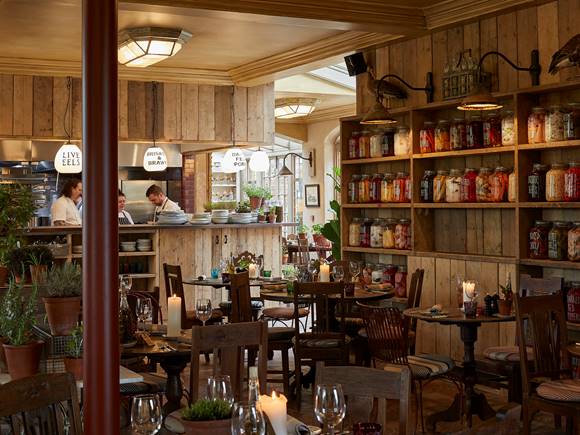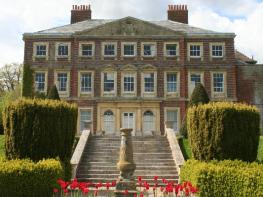Overlooking the Brabourne vineyards, The Five Bells inn offers boutique-style contemporary rooms…
Around Elham

3.75 miles (6kms)
About the walk
Although you'll cross the course of the Nail Bourne on both the outward and return legs of this walk, the chances are that you won't be aware of it – for this is Kent's most elusive stream and it only flows in the wettest winters. The waters (bourne is an old local word for stream) used to be known as the Woe Waters, for their flow was once believed to herald death or disaster.
The Nail Bourne has strong associations with the conversion of Kent to Christianity. Although some Britons became Christians during the Roman occupation (AD 43–406), the country gradually returned to paganism when the Romans left. When St Augustine came to this part of England in AD 597 to convert the Anglo-Saxons to Christianity, the county had experienced an extended period of drought. Crops had failed, animals had died and the local people began to feel that their interest in this new religion had offended their pagan gods. The Christian priests, sensing trouble, hastily began to pray for rain. Legend has it that, on the spot where St Augustine knelt to pray, a spring miraculously – and conveniently – appeared and flowed through what is now the Elham Valley. Furious at this display of Christian power, the pagan gods were said to have dried the stream, which God, just as promptly, made flow again.
This supernatural struggle is said to explain why the stream still disappears in dry weather. In fact, the Nail Bourne is an example of a winterbourne – a seasonal stream that is a distinctive feature of chalklands. They occur because chalk is porous and rain quickly seeps down through it and disappears from view. However, if there is a thick layer of clay further down, a spring develops. This spring will only turn into a stream if it is extremely wet – so winterbournes appear and disappear as if by magic. The wildlife that lives in these streams is especially adapted to survive drought, then reproduce and colonise rapidly as soon as water returns.
Just as mysterious as the Nail Bourne was the 'dammed elusive' Scarlet Pimpernel, the fictional character who saved so many French aristocrats from the guillotine. It is said that the man on whom Baroness Orczy (1865–1947) modelled her swashbuckling hero, used to stop at the Rose and Crown, an old staging post in Elham, before galloping off on his way to France to save real-life aristocrats from the revolutionaries. The Baroness, a Hungarian who settled in the Kent village of Bearsted, was a slightly eccentric character. She liked to travel around in a coach and four, and expected local people to show their respect by curtseying or doffing their caps. If they didn't she would react by throwing an undignified tantrum.
Walk directions
From the church walk down Duck Street, then head uphill to a footpath on the right. Take the bridleway up steps through trees on the right. Go through a gate and continue diagonally uphill through the field beyond, making for the stile in the far corner. Follow the track beyond through two more metal gates to the road.
Cross here and follow the footpath ahead, through a gate, then along the field edge. The path goes downhill through a couple more gates, then up along a field-edge past a pylon.
Go past a small wood, through a gate and continue straight across the large field ahead bearing half-right towards a corner of planted woodland just left of a line of telegraph poles. At the bottom of the slope, go through a gate which takes you into an army training area (a sign tells you to keep to the waymarked path), then walk up the woodland margin. At the corner of the trees, walk straight up the field to a stile and the road. Walk ahead to the road junction. The gated drive on your right leads to St Martin's Church.
Turn left and continue until you pass The Oast House. Turn left just after this, then take the right-hand path to the Old Rectory, signed 'Private Road'. Go through a kissing gate immediately in front of the house, then cross a meadow. After a further gate your route leads over a field. At the far side, go through another gate, turn left and walk along a field-edge. After another gate the path goes steeply downhill to the valley bottom, then rises again, through another gate, to join a concrete track up to the farm. Where the track bears left, take the right-hand gate and walk through the farm buildings (there may be livestock at this point). Go through a gate and turn left when you reach the road.
At Standardhill farmhouse fork right and continue under a line of pylons. Just after a copse the lane bears left. Take the footpath ahead between fields. Bear diagonally left across another field following the clearly marked path. On the far side, find a kissing gate and two steps down to the next field.
Keeping the fence on your right, follow it round to the corner, then downhill through another gate. Head straight across the next field and bear left along the field-edge. Look for a gate on your right, followed by a concrete footbridge leading over the Nail Bourne again. Walk diagonally across the field in the direction of the church. One more gate brings you up to a lane and back to the village square.
Additional information
Well-marked field tracks and footpaths, several stiles
Fertile fields and lush green valley
Dogs on lead through grazed areas
OS Explorer 138 Dover, Folkestone & Hythe
By Elham church on the village square
Village centre on the main street
WALKING IN SAFETY
Read our tips to look after yourself and the environment when following this walk.
Find out more
Also in the area
About the area
Discover Kent
The White Cliffs of Dover are an English icon – the epitome of our island heritage and sense of nationhood. They also mark the point where the Kent Downs AONB, that great arc of chalk downland stretching from the Surrey Hills and sometimes known as ‘the Garden of England’, finally reaches the sea. This is a well-ordered and settled landscape, where chalk and greensand escarpments look down into the wooded Weald to the south.
Many historic parklands, including Knole Park and Sir Winston Churchill’s red-brick former home at Chartwell, are also worth visiting. Attractive settlements such as Charing, site of Archbishop Cranmer’s Tudor palace, and Chilham, with its magnificent half-timbered buildings and 17th-century castle built on a Norman site, can be found on the Pilgrim’s Way, the traditional route for Canterbury-bound pilgrims in the Middle Ages.
In the nature reserves, such as the traditionally coppiced woodlands of Denge Wood and Earley Wood, and the ancient fine chalk woodland of Yockletts Bank high on the North Downs near Ashford, it is still possible to experience the atmosphere of wilderness that must have been felt by the earliest travellers along this ancient ridgeway.
Nearby stays
Restaurants and Pubs
Nearby experiences
Recommended things to do
Why choose Rated Trips?
Your trusted guide to rated places across the UK
The best coverage
Discover more than 15,000 professionally rated places to stay, eat and visit from across the UK and Ireland.
Quality assured
Choose a place to stay safe in the knowledge that it has been expertly assessed by trained assessors.
Plan your next trip
Search by location or the type of place you're visiting to find your next ideal holiday experience.
Travel inspiration
Read our articles, city guides and recommended things to do for inspiration. We're here to help you explore the UK.













